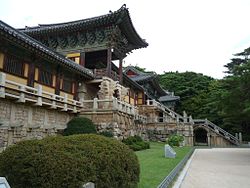Bulguksa
| Seokguram Grotto and Bulguksa Temple | |
|---|---|
| Name as inscribed on the World Heritage List | |
 |
|
| Location | Republic of Korea |
| Type | Cultural |
| Criteria | i, iv |
| Reference | 736 |
| UNESCO region | Asia-Pacific |
| Inscription history | |
| Inscription | 1995 (19th Session) |
| Bulguksa | |
| Hangul | |
|---|---|
| Hanja | |
| Revised Romanization | Bulguksa |
| McCune–Reischauer | Pulguksa |
Bulguksa is located on the slopes of mount Toham (Jinheon-dong, Gyeongju city, North Gyeongsang province, South Korea). It is a head temple of the Jogye Order of Korean Buddhism and encompasses seven National treasures of South Korea, including the Dabotap and Seokgatap stone pagodas, Cheongun-gyo (Blue Cloud Bridge), and two gilt-bronze statues of Buddha. The temple is classified as Historic and Scenic Site No. 1 by the South Korean government. In 1995, Bulguksa was added to the UNESCO World Heritage List together with the Seokguram Grotto, which lies four kilometers to the east.
The temple is considered as a masterpiece of the golden age of Buddhist art in the Silla kingdom. It is currently the head temple of the 11th district of the Jogye Order of Korean Buddhism.
Among the earliest woodblock prints in the world, a version of the Dharani sutra dated between 704 and 751 was found there in 1966. Its Buddhist text was printed on a 8 cm × 630 cm (3.1 in × 248.0 in) mulberry paper scroll.
The temple's records state that a small temple was built on this site under King Beopheung in 528. The Samguk Yusa records that the current temple was constructed under King Gyeongdeok in 751, begun by Prime Minister Kim Daeseong to pacify the spirits of his parents. The building was completed in 774 by the Silla royal court, after Gim's death, and given its current name Bulguksa (Temple of the Buddha Land).
...
Wikipedia
